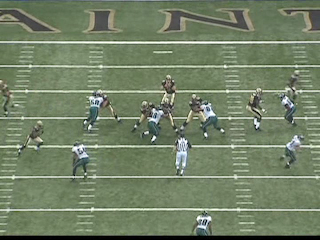Essentially, just like Y stick, the receivers look to attack the defenders and work to gain horizontal separation. Multiple shallow receivers dispersed along the same plane, puts underneath players (such as linebackers) into a 'pickle' scenario. Choosing one receiver, only opens another.
These pictorials show the contraction and expansion of this route combo. All the receivers set their 'stick' or plant aiming at underneath defender seams.
As the two inside breaking routes put the MLB in conflict, it also draws the OLBs inside the hashes (carrying the route). As this first illustration shows, bunching all the defenders inside creates a chasm for flaring backs.
As seen here, the H, Reggie Bush, has 10 yards between him and the hapless WLB because the flat defender has constricted with the inside breaking X.
Here, we see a crucial short-yardage, mid-field conversion down and we see the spacing concept relied upon (especially by the Saints) as a bread-and-butter stallwart in their offense.
A 2-back formation is presented with 21 personnel (dictating a 3 LB defense) on a short-yardage down. Because a fullback is presented, the threat of a lead run (iso or power) must be respected to prevent the 1st down.
This pictorial probably best illustrates the 1,2, and a BIG 3 in the timing of the drop.
As the WLB frantically rallies to the flaring Reggie Bush, he inadvertantly opens the seam to 1st outside receiver (Colston).
You can see in these next pics the chasm between both inside stemming receivers, putting the MLB & SLB in a can't-win scenario. Brees delivers the ball to the shoulder furthest away from the 'danger player' in the receivers area. This causes Colston (#12) to turn his body to accept the throw and be in position to run away from the nearest defender (for positive yards)
To see this particular game in action;
For more information on Spacing,check out;






















No comments:
Post a Comment